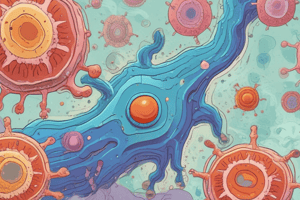Podcast
Questions and Answers
Which organism is NOT mentioned as a source of parasitic infection through contaminated food?
Which organism is NOT mentioned as a source of parasitic infection through contaminated food?
- Taenia solium
- Capillaria philippinensis (correct)
- Diphyllobothrium latum
- Entamoeba histolytica
What is the primary mode of transmission for the majority of infections with cestodes and intestinal protozoans?
What is the primary mode of transmission for the majority of infections with cestodes and intestinal protozoans?
- Transmission through insect vectors
- Direct contact with infected individuals
- Ingestion of contaminated food and water (correct)
- Inhalation of contaminated air
Which of the following parasites is associated with autoinfection?
Which of the following parasites is associated with autoinfection?
- Diphyllobothrium latum
- Ascaris lumbricoides
- Taenia saginata
- Strongyloides stercoralis (correct)
Which condition results from massive infection with Strongyloides due to hyperinfection?
Which condition results from massive infection with Strongyloides due to hyperinfection?
What is the common source of eggs that favor the development of Ascaris lumbricoides and other nematodes?
What is the common source of eggs that favor the development of Ascaris lumbricoides and other nematodes?
Which of these belongs to the group of intestinal protozoans mentioned as causing parasitic infection?
Which of these belongs to the group of intestinal protozoans mentioned as causing parasitic infection?
Which organism is primarily transmitted through contaminated water rather than food?
Which organism is primarily transmitted through contaminated water rather than food?
What process results in superinfection with a parasite already present in an individual?
What process results in superinfection with a parasite already present in an individual?
What likely portal of entry is associated with the spread of parasitic infections?
What likely portal of entry is associated with the spread of parasitic infections?
Which of the following statements is true regarding the life cycle changes of Strongyloides?
Which of the following statements is true regarding the life cycle changes of Strongyloides?
Flashcards are hidden until you start studying
Study Notes
Entamoeba Histolytica and Its Mechanisms
- Trophozoites possess hooks and suckers that anchor the parasite in the host's body, aiding in tissue migration.
- Cystein proteinases secreted by Entamoeba histolytica enable it to penetrate intestinal mucosa and adhere to underlying tissues.
- Notably, no such enzymes are found in commensal Entamoeba coli.
Schistosoma and Tissue Penetration
- Cercariae of Schistosoma have specialized penetration glands that produce an enzyme digesting host skin, facilitating entry.
- The thickened integument protects the parasite against digestive enzymes and dehydration.
Cestode Embryos and Tissue Engagement
- All cestode embryos feature six hooklets, enhancing their ability to penetrate tissues before becoming encysted larvae.
Host Interaction and Damage
- Parasites can coexist within hosts, often causing damage through various mechanisms.
- Injury induced by parasites can result from chronic inflammation, competition for nutrients, or direct tissue destruction.
Reproductive Systems of Flatworms
- Flatworm reproductive systems are typically elaborate and complex, crucial for their lifecycle and propagation.
Sources of Infection
- Common sources for parasitic infections include contaminated food, water, soil, and lack of sanitation.
- Pathogens like Ascaris lumbricoides, Trichuris trichiura, and others thrive in unhygienic conditions, particularly in the context of using human waste as fertilizer.
Modes of Transmission
- The mouth serves as the main entry point for many parasites, especially those transmitted via contaminated food and water.
- Noteworthy examples include Taenia solium and Taenia saginata from undercooked meat, and Entamoeba histolytica from contaminated drinking water.
Autoinfection Mechanisms
- Autoinfection occurs when an infected individual harbors a higher worm burden due to self-contamination.
- This is seen in the lifecycle of Strongyloides, Capillaria philippinensis, and Enterobius vermicularis, where rhabditiform larvae develop into filariform in the host's gut.
Studying That Suits You
Use AI to generate personalized quizzes and flashcards to suit your learning preferences.




